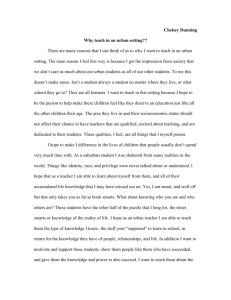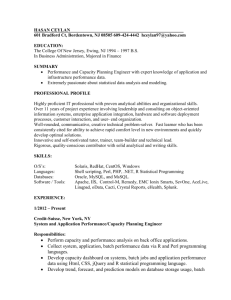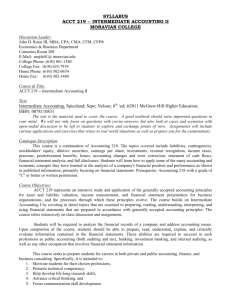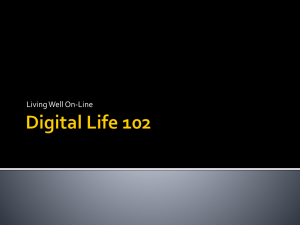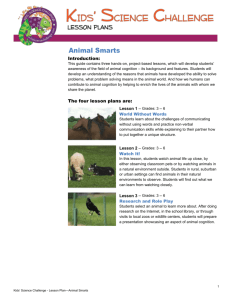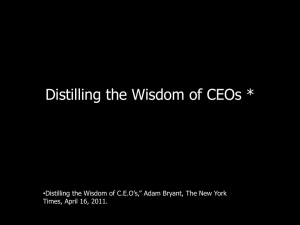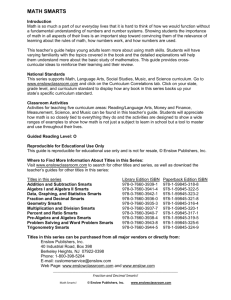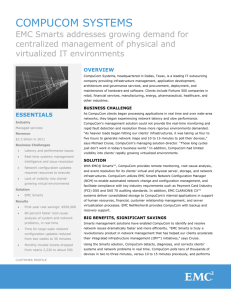Noel M. O`Boyle
advertisement
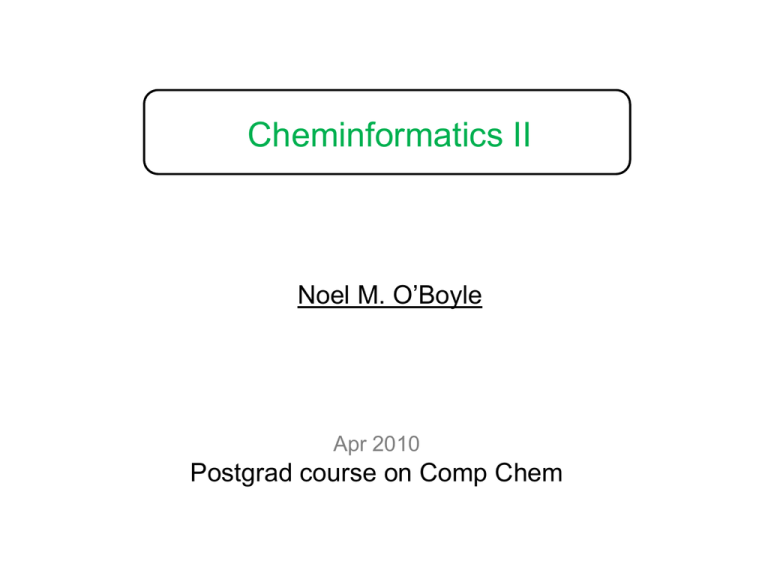
Cheminformatics II Noel M. O’Boyle Apr 2010 Postgrad course on Comp Chem Substructure search using SMARTS • SMARTS – an extension of SMILES for substructure searching – (“regular expressions for substructures”) • Simple example – Ether: [OD2]([#6])[#6] • Any oxygen with exactly two bonds each to a carbon • Can get more complicated – Carbonic Acid or Carbonic Acid-Ester: [CX3](=[OX1])([OX2])[OX2H,OX1H0-1] • Hits acid and conjugate base. Won't hit carbonic acid diester • Example use of SMARTS – Create a list of SMARTS terms that identify functional groups that cause toxicological problems. – When considering what compounds to synthesise next in a medicinal chemistry program, search for hits to these SMARTS terms to avoid synthesising compounds with potential toxicological problems – FAF-Drugs2: Lagorce et al, BMC Bioinf, 2008, 9, 396. FAF-Drugs2: Free ADME/tox filtering tool to assist drug discovery and chemical biology projects, Lagorce et al, BMC Bioinf, 2008, 9, 396. Calculation of Topological Polar Surface Area • TPSA – Ertl, Rohde, Selzer, J. Med. Chem., 2000, 43, 3714. – A fragment-based method for calculating the polar surface area Quantitative Stucture-Activity Relationships (QSAR) • Also QSPR (Structure-Property) – Exactly the same idea but with some physical property • Create a mathematical model that links a molecule’s structure to a particular property or biological activity – Could be used to perceive the link between structure and function/property – Could be used to propose changes to a structure to increase activity – Could be used to predict the activity/property for an unknown molecule • Problem: Activity = 2.4 * Does not compute! • Need to replace the actual structure by some values that are a proxy for the structure - “Molecular descriptors” • Numerical values that represent in some way some physico-chemical properties of the molecule • • • We saw one already, the Polar Surface Area Others: molecular weight, number of hydrogen bond donors, LogP (octanol/water partition coefficient) It is usual to calculate 100 or more of these Building and testing a predictive QSAR model • Need dataset with known values for the property of interest • Divide into 2/3 training set and 1/3 test set • Choose a regression model – Linear regression, artificial neural network, support vector machine, random forest, etc. • Train the model to predict the property values for the training set based on their descriptors • Apply the model to the test set – Find the RMSEP and R2 • Root-mean squared error of prediction and correlation coefficient • Practical Notes: – Descriptors can be calculated with the CDK or RDKit – Models can be built using R (r-project.org) – For a combination of the two, see rcdk Lipinski’s Rule of Fives Chris Lipinski Note: Rule of thumb Rule of Fives Oral bioavailability • • • Took dataset of drug candidates that made it to Phase II Examined the distribution of particular descriptor values related to AMDE An orally active drug should not fail more than one of the following ‘rules’: – – – – • Molecular weight <= 500 Number of H-bond donors <= 5 Number of H-bond acceptors <= 10 LogP <= 5 These rules are often applied as an pre-screening filter Image: http://collaborativedrug.com/blog/blog/2009/10/07/cdd-community-meeting/ Cheminformatics resources • Programming toolkits: Open Source – OpenBabel (C++, Perl, Python, .NET, Java), RDKit (C++, Python), Chemistry Development Kit [CDK] (Java, Jython, ...), PerlMol (Perl), MayaChemTools (Perl) – Cinfony (by me!) presents a simplified interface to all of these • See http://cinfony.googlecode.com for links to an online interactive tutorial and a talk • Command-line interface: – OpenBabel (“babel”) See http://openbabel.org/wiki/Babel for information on filtering molecules by property or SMARTS • See http://openbabel.org/wiki/Tutorial:Fingerprints for similarity searching, – MayaChemTools • GUI: – OpenBabel • Specialized toolkits: – OSRA: image to structure – OPSIN: name to structure – OSCAR: Identify chemical terms in text • Building models: R (http://r-project.org), rcdk
